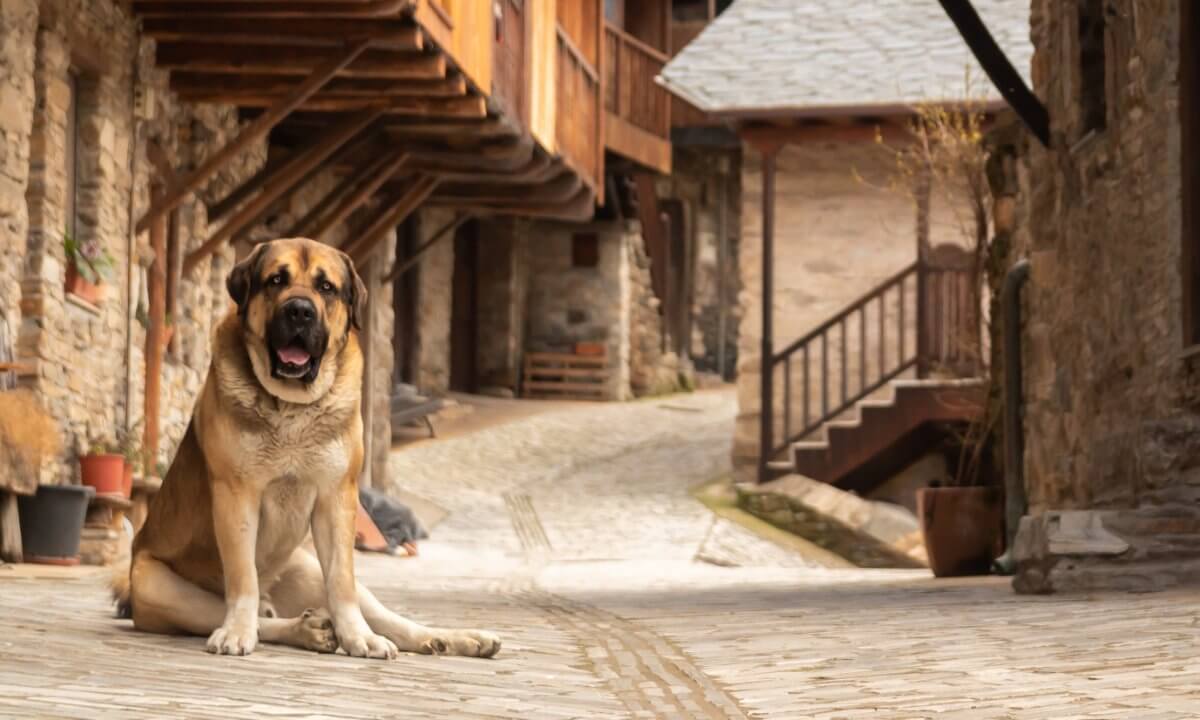


Home » Meet the Breed: Five Things to Consider Before Bringing Home a Spanish Mastiff

One of the most intriguing molosser dog breeds that most people have likely never heard of is the Spanish Mastiff. This imposing breed can take on an almost Saint Bernard-like appearance, but it is very different in origin and backstory.
The Mastín Espanol originates from Spain and is one of the oldest breeds in existence. The breed first appeared on the Iberian Peninsula before the Roman invasion, brought to the region by the Greeks and Phoenicians more than 2,000 years ago.
Originally bred to be a guard dog to protect livestock, the Spanish Mastiff is truly a massive dog, measuring, at a minimum, 28-35 inches tall and weighing between 140 and 200 pounds. (Some individuals of the breed can be even heavier than that!) The FCI Breed Standard for the breed, which is not yet fully recognized by the American Kennel Club (AKC), describes this mastiff from a purely temperament perspective as follows:
“It is a very intelligent dog, not without beauty, whose expression manifests both these qualities. Rustic, affectionate, kind and noble, he is very determined when facing dangerous animals and in front of strangers, especially when he has the opportunity to defend and protect farms or cattle. In his behaviour, one can see it is a dog sure of himself, determining his strength because he is aware of his enormous power.”
The Spanish Mastiff has been recorded in the AKC Foundation Stock Service since August 2008.
Here’s a look into five things to know before bringing home a Spanish Mastiff:
Due to its size and nature, the Spanish Mastiff requires early training and socialization. Without this foundation, an owner can quickly end up with a problem on their hands due to the sheer power that comes with a muscular dog that was bred to serve as a guardian. Consequently, it’s not a good idea to take this breed to a dog park.
Puppy classes are recommended to get the Spanish Mastiff comfortable around other dogs and people from a young age. While they can become loyal family companions, it’s best to keep this robust dog supervised around young children and smaller animals. Though each individual dog of any breed is unique, in most cases, it’s best for this mastiff to live in a household with older children (if any) and with animals that it is introduced to from puppyhood.
The Spanish Mastiff requires daily exercise, with the recommendation that the dog receives about an hour of exercise per day. But it should be noted, this is a medium-energy and not a high-energy breed. So, a molosser like this one doesn’t need the same type of strenuous activity that a Cane Corso may be looking for.
Activities that are mentally stimulating are important for the Spanish Mastiff, and it’s always a positive experience to give these dogs some opportunity to roam about in a large, enclosed space. It’s because of this need to roam, and the breed’s size, that it should be taken into consideration that this dog is not the best option for anyone living in an apartment or a particularly small dwelling.
When exercising out in public, it’s also important to be wary of other dogs and to be proactive with close interactions with strangers.
The maintenance grooming of a Spanish Mastiff isn’t very difficult—it comes down to the basics of grooming a dog with a dense, thick, semi-long coat. Bathing is recommended weekly for show dogs, but at least once per month is sufficient to keep the typical coat clean and free of dirt and debris. The breed sheds at a higher rate in the spring and the fall, so more brushing will be required during these seasons.
The Spanish Mastiff is also a breed that drools frequently, so it’s best to be sure to keep a drool rag handy at all times. Similarly, if you plan to keep this mastiff in your personal living areas on a frequent basis, it will be essential to protect your furniture and flooring.
A number of giant breeds can come with a slew of health concerns, but the Spanish Mastiff overall is a generally healthy breed. Make sure your mastiff’s breeder screens for hip issues and is aware of any heart problems or eye concerns. As with many dogs of this size and conformation, bloat can also be a concern. Providing regular veterinary checkups can help to identify and manage any of the aforementioned health issues if they should arise.
One of the biggest concerns for larger dogs like the Spanish Mastiff is the stress on the joints that can occur in overweight individuals. That being said, it is essential to take into consideration the cost of dog food as a part of your investment in making one of these big dogs a member of your family—it’s far from the smallest of bills!
It is typically best to put these dogs on a food specifically formulated for large breeds, and it’s recommended to feed them a whopping 6-10 cups per day. Puppies between 3-6 months old should eat three times per day, while puppies between 6-12 months old should eat only twice a day. Once a Spanish Mastiff is past one year of age, it’s usually okay to feed them just once per day.
